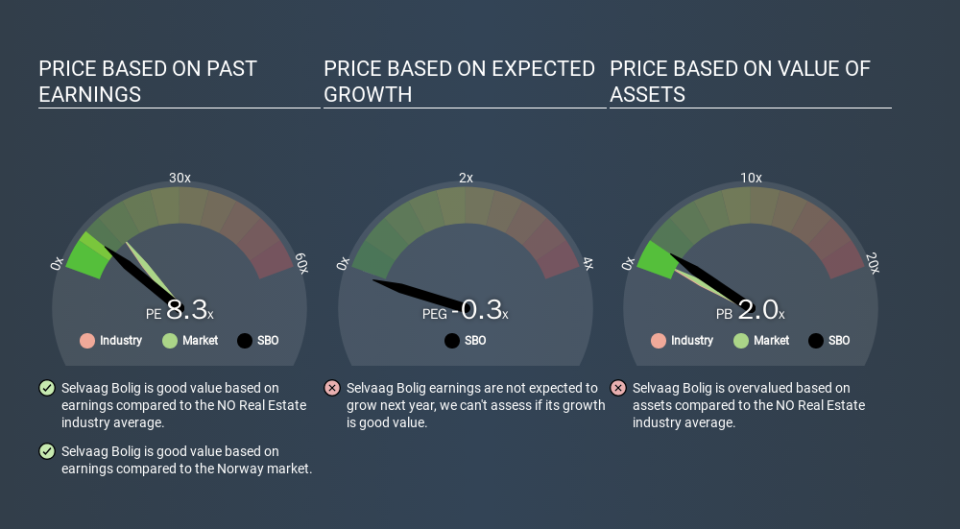A Rising Share Price Has Us Looking Closely At Selvaag Bolig ASA's (OB:SBO) P/E Ratio

It's great to see Selvaag Bolig (OB:SBO) shareholders have their patience rewarded with a 30% share price pop in the last month. That brought the twelve month gain to a very sharp 62%.
Assuming no other changes, a sharply higher share price makes a stock less attractive to potential buyers. While the market sentiment towards a stock is very changeable, in the long run, the share price will tend to move in the same direction as earnings per share. The implication here is that deep value investors might steer clear when expectations of a company are too high. One way to gauge market expectations of a stock is to look at its Price to Earnings Ratio (PE Ratio). Investors have optimistic expectations of companies with higher P/E ratios, compared to companies with lower P/E ratios.
See our latest analysis for Selvaag Bolig
How Does Selvaag Bolig's P/E Ratio Compare To Its Peers?
Selvaag Bolig's P/E of 8.34 indicates relatively low sentiment towards the stock. If you look at the image below, you can see Selvaag Bolig has a lower P/E than the average (14.7) in the real estate industry classification.
Selvaag Bolig's P/E tells us that market participants think it will not fare as well as its peers in the same industry. Since the market seems unimpressed with Selvaag Bolig, it's quite possible it could surprise on the upside. If you consider the stock interesting, further research is recommended. For example, I often monitor director buying and selling.
How Growth Rates Impact P/E Ratios
P/E ratios primarily reflect market expectations around earnings growth rates. Earnings growth means that in the future the 'E' will be higher. That means unless the share price increases, the P/E will reduce in a few years. So while a stock may look expensive based on past earnings, it could be cheap based on future earnings.
Selvaag Bolig's 99% EPS improvement over the last year was like bamboo growth after rain; rapid and impressive. The cherry on top is that the five year growth rate was an impressive 43% per year. With that kind of growth rate we would generally expect a high P/E ratio.
Don't Forget: The P/E Does Not Account For Debt or Bank Deposits
Don't forget that the P/E ratio considers market capitalization. So it won't reflect the advantage of cash, or disadvantage of debt. In theory, a company can lower its future P/E ratio by using cash or debt to invest in growth.
While growth expenditure doesn't always pay off, the point is that it is a good option to have; but one that the P/E ratio ignores.
Is Debt Impacting Selvaag Bolig's P/E?
Selvaag Bolig's net debt equates to 33% of its market capitalization. While that's enough to warrant consideration, it doesn't really concern us.
The Verdict On Selvaag Bolig's P/E Ratio
Selvaag Bolig has a P/E of 8.3. That's below the average in the NO market, which is 13.4. The EPS growth last year was strong, and debt levels are quite reasonable. If the company can continue to grow earnings, then the current P/E may be unjustifiably low. What we know for sure is that investors are becoming less uncomfortable about Selvaag Bolig's prospects, since they have pushed its P/E ratio from 6.4 to 8.3 over the last month. For those who like to invest in turnarounds, that might mean it's time to put the stock on a watchlist, or research it. But others might consider the opportunity to have passed.
When the market is wrong about a stock, it gives savvy investors an opportunity. If the reality for a company is not as bad as the P/E ratio indicates, then the share price should increase as the market realizes this. So this free visual report on analyst forecasts could hold the key to an excellent investment decision.
Of course, you might find a fantastic investment by looking at a few good candidates. So take a peek at this free list of companies with modest (or no) debt, trading on a P/E below 20.
If you spot an error that warrants correction, please contact the editor at editorial-team@simplywallst.com. This article by Simply Wall St is general in nature. It does not constitute a recommendation to buy or sell any stock, and does not take account of your objectives, or your financial situation. Simply Wall St has no position in the stocks mentioned.
We aim to bring you long-term focused research analysis driven by fundamental data. Note that our analysis may not factor in the latest price-sensitive company announcements or qualitative material. Thank you for reading.

